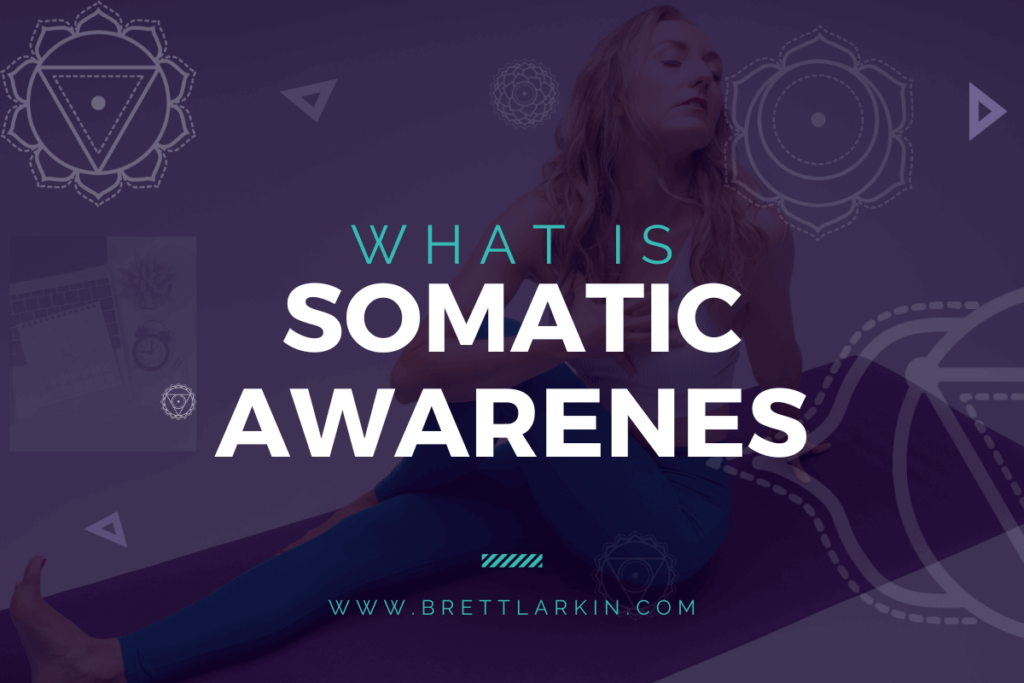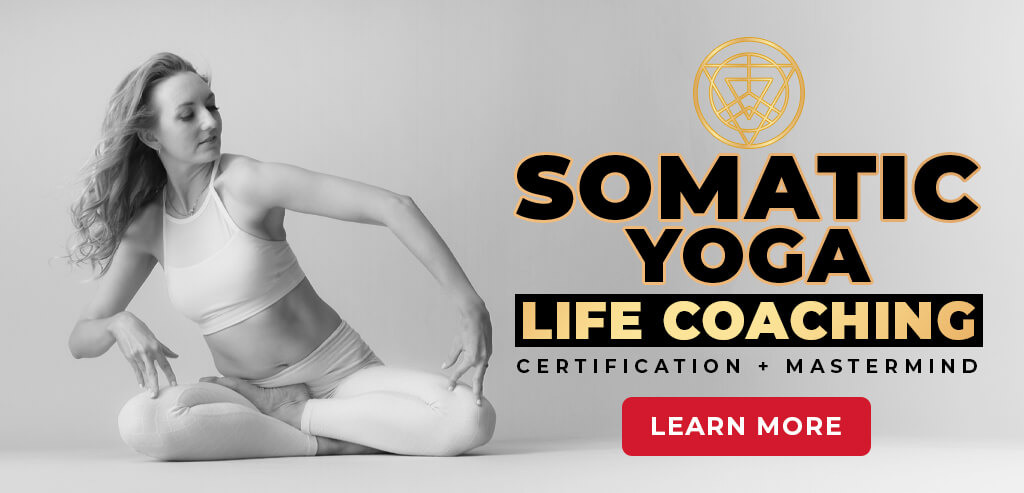
By now, you’ve probably heard the word “somatic” somewhere on the Internet and maybe you’re thinking: What does it even mean?!
Don’t worry, I’ve got you covered. Somatics literally means having to do with the body.
So what is somatic awareness? You guessed it! It’s body awareness.
In our crazy modern world, so many of us are running around without mind-body awareness.
But that can change and it’s not as hard as you think. If you’re already a yogi, then you practice somatic awareness on the mat already. You can deepen your practice there, and take that awareness with you everywhere you go.
Ready to get started?
What Is Somatic Awareness?
Somatic awareness is your ability to perceive and understand physical sensations and movements within your own body. Sounds easy right? Well, it goes a bit deeper. It means being in the present moment, attuned not only to your bodily sensations, but to your feelings, visceral responses, and the sensory experiences of your muscles, joints, organs, and other bodily functions.
Somatic therapy offers people a way to learn more about their bodily sensations through a therapeutic approach. Many people who have had traumatic experiences or suffer from a psychological condition or a physiological condition benefit greatly from somatic therapy.
Peter Levine is credited with the development of somatic experiencing therapy, which shifted trauma treatment to focusing on the body, instead of only the mind. While he developed this new modality, he discovered that our bodies are designed to heal from highly stressful or trauma-inducing events, which can even help reduce pain. By including somatic awareness in a patient treatment plan, it can encourage better outcomes.
That’s right! Our bodies are magical and self-healing. The way to tap into this self-healing power is by understanding how your unique body works, what symptoms are showing up, and what might contribute to better mindfulness in your day to day existence.
No matter where you’re at in life, developing a strong somatic awareness is one of the most healing things you can do for your well being, mental health, and mind body connection.
Why Somatic Awareness Is Healing
Without somatic awareness, you can’t practice mindfulness meditation, experience feelings as they arise, or even feel the connection between the mind and body. To increase somatic awareness, first, you have to feel safe.
Feelings of distress, fear, and pain instantly make your awareness (and your health) go haywire, while feelings of numbness, symptoms of depression, and lack of motivation take your awareness offline. In order to have any form of self regulation and healing, the approach is safety first, then awareness.
The stressors of modern life can seem overwhelming. Therapy is a wonderful tool, but if you can also increase somatic awareness, you’re better able to cope with what life throws at you.
Experience My Somatic Yoga Workshop (usually $67) FREE!👇

Somatic Awareness and Your Brain
Did you know that practicing somatic awareness can literally affect your brain structures?
This is big news for any patient in therapy treatment dealing with depression, distress, and symptoms of health issues. Understanding how the mind body connection works and the benefits of somatic therapy is game-changing.
Neuroplasticity
Somatic therapy practices have been associated with neuroplasticity – the brain’s ability to reorganize itself by forming new neural connections.
A 2018 study proved that mindfulness practices, including those focused on the body, can contribute to structural changes in the brain, particularly in areas related to attention, emotional regulation, and self-awareness.
The Amygdala
The amygdala is your survival center – the region of the brain associated with the processing of emotions, particularly anxiety and stress. Somatic therapy and awareness practices, by promoting relaxation and reducing distress, influence the amygdala’s activity. This can lead to a decreased reactivity to stressors and a more balanced emotional response.
In one study, the amygdala even appeared to shrink after only 8 weeks of somatic awareness practice.So, if practicing mindfulness meditation makes you feel more calm and controlled, then science is backing you! It’s known to be helpful in soothing symptoms that the amygdala usually flares up.
Prefrontal Cortex Activation
The prefrontal cortex is where all your decision-making, problem-solving, and impulse control happens.
When you become more aware, this area of the brain can show increased activity, meaning improved cognitive control, a better ability to regulate emotions, and a better decision-making process.
A 2022 study showed that somatic awareness practices help this part of your brain have a better memory and attention span too!
7 Benefits of Somatic Awareness
Here are few of the top benefits of somatic awareness:
1. Stress Reduction
Somatic awareness practices, like mindfulness and body scan techniques, can help you become more aware of the body sensations associated with stress. By paying attention to these sensations without judgment, you can learn to respond to stressors in a more calm, grounded way. Your health will thank you.
2. Emotional Regulation
Ever have one of those moments where you can feel the steam releasing from the top of your head? Somatic awareness allows you to connect with your emotions as they manifest in your body.
By recognizing and accepting these bodily sensations, no matter what they are, you can learn to soothe your nervous system, even in the most triggering circumstances. If you deal with anxiety, depression, or trauma, this is one of the best benefits self-awareness offers. Think of it as knowing your mental symptoms, along with your physical ones.
3. Release of Physical Tension
If you’re like most people, your body is carrying a lot of tension. Most of us have learned to physically brace when stress is near, which can then lead to chronic pain down the road. Somatic experiencing therapy releases this built-up tension. When you have awareness of where the tension resides in your body, you can consciously relax those tense muscles, and feel a sense of relief and relaxation. This is why somatic therapy has become so popular in recent years!
4. Improved Self-Esteem
If you start practicing somatic mindfulness, you’re really developing a new friendship with the most important person in your world: YOU! Somatic awareness is like a bridge to a healthier relationship with your body and mind.
By practicing non-judgment, you’ll feel a more accepting attitude towards who you are, your body, your emotions, and your health. Think of this as finally opening the lines of communication with a long-lost friend. The more you listen to the mind body, the more capacity you’ll have for connection with others.
5. Resilience
Everyone has something stressful in their lives, so learning the importance of being patient, and strengthening your response to life’s curveballs is a practice. Developing somatic awareness can help you in the face of life’s challenges.
When you’re more in tune with your body, you’re more equipped to cope with stressors and bounce back from difficult experiences. Even just learning how to inhale and exhale through those triggering moments is a game-changer.
6. Being Present
So many of us are physically present, but our minds are elsewhere. With mindfulness meditation, you learn to be fully in the moment. If you struggle with getting stuck on loops of thought, this can break the cycle of rumination about the past or worries about the future. Somatic awareness brings you fully into the now.
7. Support for Trauma Recovery
For anyone who has experienced trauma, somatic therapy can be an essential component of the healing process, especially in terms of mental health. Trauma often manifests in the body as a wide variety of symptoms, and somatic practices can help you gently reconnect with your body in a safe, controlled way.
5 Methods to Increase Somatic Awareness
Here are three ways you can instantly develop more somatic awareness today. Some of these somatic healing methods are used in somatic therapy, but you can practice each technique on your own. All of these will benefit your health in some way if you commit to a daily practice.
1. Body scan
A mindful body scan is a great way to get back into the body and it’s often used in somatic therapy. To begin a body scan, find a comfortable position. Close your eyes and bring your attention to your breath, grounding yourself in the present moment.
Starting at the toes, gradually move your focus up through each part of the body. As you focus on a particular area, pay attention to any sensations, tension, or warmth you feel, without judgment.
Breathe deeply and intentionally, allowing your breathing to bring relaxation to the area being observed.
Progress through each body part, moving toward the crown of the head.
This body scan helps you cultivate a non-judgmental awareness of your physical sensations, fostering a deeper connection between the mind and body, and promoting a state of relaxation and well being.
2. Yoga Nidra
Similar to the body scan, Yoga Nidra (also known as yogic sleep) is a guided meditation practice done in a comfortable lying position. It’s like a body scan plus breath awareness, and visualizations.
This practice induces a state of deep relaxation while maintaining awareness, promoting a sense of inner peace and rejuvenation.
If you want to uplevel your body scan, I encourage you to try this. For those with chronic pain, yoga nidra can be a key part of somatic therapy.
3. Shake it off
Shaking your body can release feelings of “fight, flight, freeze, or fawn.” Ever seen a dog shake or a cat stretch? Your body intuitively knows how to do the same. Our bodies are a part of nature, so we just need to get out of the way and let them move!
You can try shaking one limb at a time, like your arms or your legs, or shaking the whole body at once. It can also help move stuck emotions, such as fear, anger, or symptoms of anxiety.
Maybe try a Breath of Fire or put on your favorite Taylor Swift song (I suggest “Shake it Off”) and get physical. Let your body move to the music, shaking out any emotions, anxiety, or stress.
4. Tapping (EFT)
Tapping, also known as (Emotional Freedom Techniques – EFT), involves just what you’d expect: gently tapping or massaging specific points on the body, usually on the face, upper body, and hands.
As you do this, you focus on addressing a particular issue or emotion.
This practice combines physical touch with cognitive awareness and helps release emotional blockages. It’s used for stress reduction, anxiety management, and promoting a sense of calm.
5. Progressive muscle relaxation (PMR)
Progressive muscle relaxation is like taking a soothing energetic bath. The practice involves progressively tensing and then relaxing different muscle groups in the body.
Start with the toes and work your way up to the head, tensing each muscle group for a few seconds before releasing.
This practice helps release physical tension, promotes relaxation, and increases body awareness. It’s effective for managing stress and anxiety. Many people in traditional therapy will recognize this exercise too, as it’s become so popular as a way to ease anxious feelings.
Experience My Somatic Yoga Workshop (usually $67) FREE!👇

3 Somatic Grounding Exercises
Once you have an understanding of somatic awareness, you can practice somatic grounding – a.k.a. anchoring yourself in the physical sensations of the body, wherever you are.
Somatic ground reduces stress and anxiety, regulates emotions, and even helps with the process of decision making.
1. Countdown
This is one of my favorites because it works to ground you in a moment, especially if you’re stuck in an emotion or response you’d like to shift.
If you deal with anxiety, this therapeutic approach will help you get grounded in yourself again. It’s very simple. You’re going to countdown from 5 to 1, and while you do, you’ll name what you notice:
5 – Name 5 things that you can see
4 – Name 4 things that you can feel
3 – Name 3 things that you can hear
2 – Name 2 things that you can smell
1 – Name 1 thing that you can taste
2. Box Breathing
Box breathing is a rhythmic somatic breathing technique. You inhale for a count of four, hold for four, exhale for four, and hold for four. This practice helps regulate your nervous system, increase oxygenation, and create a sense of balance and focus, grounding you into the here and now. It’s a somatic therapy favorite! If panic attacks are one of your symptoms of anxiety, box breathing is a good place to begin.
3. Somatic Yoga
What most people call somatic yoga, I call embodied yoga. The somatic yoga benefits are so impressive because somatic yoga literally gives your body something to work through. The poses are not the “be all and end all” but simply a jumping off point for your own exploration.
What is Somatic Yoga – 5 Min Explainer Video 👇
The goal is to rediscover parts of your body you’ve disconnected from and safely reconnect, while soothing your nervous system and supporting your health.
If you’re ready to take your somatic awareness practice to the next level, then embodied yoga is perfect for you! You can start with this gentle practice:
Final Thoughts
True healing occurs with somatic awareness. Once you know yourself and have developed a deep sense of self-awareness, you can start living from your highest essence. Think of somatic awareness as one more tool in your health toolkit, along with yoga, therapy, getting out into nature, connection, and community.
Your embodiment journey can happen in any form, but focused somatic awareness is one of the most helpful.
If you want to go deeper, join the Uplifted Community or grab my new book YOGA LIFE to learn more.
Next Steps
- Take a deep dive into embodiment and somatic yoga with my Somatic Yoga certification program.
- If you’re interested in practical kriya yoga as a way to improve your daily life and relationships, check out my Yoga for Self Mastery course.

FREE Embodied Yoga Workshop (usually $67) Somatic Techniques & Cord Cutting Ritual

YOU MIGHT ALSO LIKE
- The Perfect Yoga Practice For Your Menstrual Cycle Energy Levels
- Enhancing Your Practice: The Benefits of Yoga and Nature Connection
- Gentle Somatic Yoga for Back Pain: Relief and Prevention Techniques
- How Somatic Yoga for Anxiety Can Help You Find Calm and Balance
- Somatic Stress Release Techniques for Emotional Balance
- Progressive Muscle Relaxation Meets Yoga for Deep Sleep
- 5 Somatic Hip Exercises For Beginners
- How To Relieve Myofascial Pain with Yoga: Heal and Prevent Muscle Tension
- Somatic Energy Healing: Techniques to Realign and Restore Balance
- How Somatic Shaking Can Release Tension and Reset Your Nervous System
- How To Create Mindful Somatic Yoga Sequences Your Students Will Love
- Somatic Yoga Poses For Every Body And Mind
- 6 Hip Openers For Emotional Release
- What Are Myofascial Release Trigger Points?
- Integrating Mind and Body: The Benefits of Somatic Bodywork
Learn how to do 11 of the most popular yoga poses correctly. Free video + PDF download.












